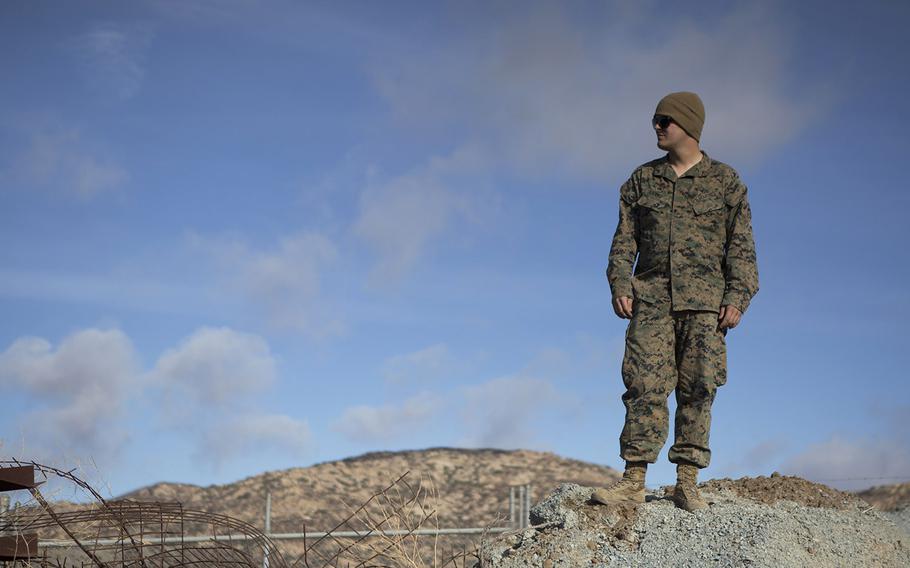
A U.S. Marine with 7th Engineer Support Battalion, Special Purpose Marine Air-Ground Task Force 7, stands at the California-Mexico border near the Tecate region on Nov. 23, 2018. (Jared Curtis/U.S. Marine Corps)
Most of the active-duty troops now stationed along the U.S.-Mexico border stringing coiled razor-wire barriers and supporting Border Patrol agents will extend their deployments through the end of January, a Defense Department official confirmed Friday.
However, about 2,000 of the 5,600 troops working along the southwest border in Texas, Arizona and California will return to their duty stations, the Defense Department official said. A timeline for returning troops home was not addressed, though the original end date of the mission was Dec. 15.
The Department of Homeland Security sent a formal request Friday to the Defense Department to keep troops through Jan. 31, according to a news release.
“This request refines support to ensure it remains aligned with the current threat, the nature of the mission, and [Customs and Border Patrol] operational requirements,” Defense Department spokesman Lt. Col. Jamie Davis said in the statement.
The request has yet to be approved by Defense Secretary Jim Mattis, The Associated Press reported. But military officials have been working with Homeland Security for weeks to help craft a request that would be accepted by the Pentagon.
Speaking to reporters Thursday, Mattis said staff members of both departments had been working on the request and final agreements came down to logistics issues of what was still needed.
As far as continuing temporary barriers, Mattis said the ports of entry were “pretty much done,” with only flanks of a couple of them remaining.
The deployment of active-duty troops began in late October with a mission to better secure the border and deter a caravan of Central American migrants from crossing the U.S.-Mexico border. At one point, the caravan swelled beyond 7,000 people, the majority from Honduras, The Associated Press reported.
For the past month, military engineers have laid miles of razor-wire barriers, some of it next to business parking lots and recreational parks along the border.
Some of the tasks assigned the troops have been completed already. As of Nov. 16, the 2,800 active-duty troops in Texas had finished their mission of “hardening” immigration entry points in the Brownsville area at the state’s most southern tip. At that time, the troops in all three states had installed 2,714 meters of razor-wire obstacles in Arizona and another 4,145 meters of razor wire in California.
In late November, deployed military police, who already carry a weapon as part of their day-to-day assignments, were granted authorization to provide force protection for the Customs and Border Protection agents who they are supporting.
The call for an extension of the troop deployment follows some violence Sunday at the San Ysidro Port of Entry in the San Diego section of the border. Demonstrations along both sides of the border ended with Border Patrol agents firing tear gas into the crowd.
Some 5,000 migrants remain on the Mexican side of the border, camping at a sports complex in Tijuana. Their numbers have decreased as many of them have lost hope of seeking asylum in the United States.
Caitlin Kenney and Corey Dickstein contributed to this report.
Thayer.rose@stripes.com Twitter: @Rose_Lori